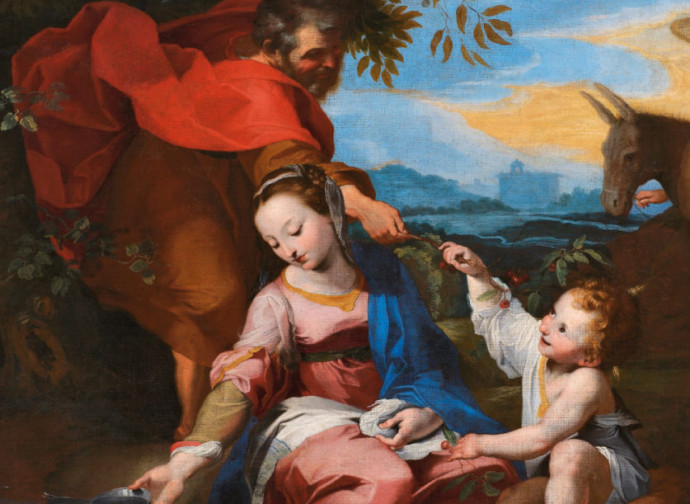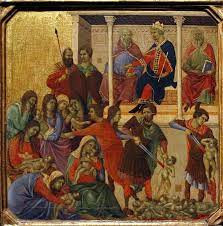Rest during the Flight into Egypt: the Holy Family portrayed by Barocci
The story of the flight into Egypt, caused by Herod, has inspired many artists over the centuries. One painting in particular touches hearts and minds: Federico Barocci's "Rest during the Flight into Egypt", which depicts a serene moment in the life (painful since childhood) of Jesus.

"When Herod realised that the Magi had tricked him, he was furious and ordered the murder of all children under two years old in Bethlehem and its territory, in response to what he had been told by the Magi. (Matthew 2:16).
 Duccio di Buoninsegna (c. 1260 - 1318/1319) masterfully depicted this criminal act in his extraordinary painting Slaughter of the Innocents: a wooden panel painted in tempera and gold, belonging to the collection of the Museo dell'Opera Metropolitana del Duomo in Siena. This massacre is part of the story of Jesus: after the Nativity, since infancy his life was to be full of extraordinary dangers.
Duccio di Buoninsegna (c. 1260 - 1318/1319) masterfully depicted this criminal act in his extraordinary painting Slaughter of the Innocents: a wooden panel painted in tempera and gold, belonging to the collection of the Museo dell'Opera Metropolitana del Duomo in Siena. This massacre is part of the story of Jesus: after the Nativity, since infancy his life was to be full of extraordinary dangers.
Herod the Great (Ashkelon 70/69 BC - Jericho, 1 AD) ruled over most of Palestine, including Judea, after the death of his father, Herod Antipater, on the orders first of Mark Antony and then of Octavian Augustus, whose side he had promptly switched to after Antony's defeat at Actium (it was a naval battle that ended the civil war between Octavian and Mark Antony, on 2 September 31 BC). On learning that a “King of the Jews” had just been born in Galilee, he felt the permanence of his throne threatened. At this news, he gave the fateful order to slaughter the little innocents, to eliminate any risk of facing a temporal rival.
The family of Jesus had no other alternative than to flee. And so they took the road to Egypt. Among the canonical Gospels, this episode of Jesus' infancy is mentioned only in Matthew's Gospel (Mt 2:13-23). The story recounts how the Magi go to Herod the Great to ask him where to find the "King of the Jews". The priests, having consulted the Holy Scriptures, indicate to the Magi the city of Bethlehem. It was then that Herod made the terrible decision to exterminate all children under the age of two. But after the Magi's visit, an angel appeared to Joseph in a dream and warned him of the imminent danger, telling him to take his spouse and son to Egypt (Mt 2:13-14), so that Jesus could escape the slaughter of the innocents.
The flight into Egypt has inspired many artists over the centuries: Caravaggio, Orazio Gentileschi, Vittorio Carpaccio, Parmigianino, Caracciolo, Titian, to name but a few. But one painting in particular touches the heart, mind, and imagination: it is the 'Rest during the Flight into Egypt' by Federico Barocci, known as Fiori (1528/1535 - 30 September 1612). He is one of the most important painters in the (often undervalued) period of art during the Counter-Reformation, in the period between Correggio and Caravaggio. Barocci's adherence to the Catholic Reformation was the source of his long and fruitful career. A key figure was St Philip Neri, whose Oratories sought to reconnect the realm of the spirit with people's everyday lives. St Philip commissioned Barocci to paint an altarpiece on the theme of the Visitation for his Chiesa Nuova (Santa Maria in Vallicella); it is said that contemplation of the painting brought him to ecstasy. In the painting, Elizabeth and the Virgin greet each other as if in the context of daily life in Rome.
Barocci also excels in the “Rest on the Flight into Egypt”: the family that is resting under a cherry tree covered in fruit gives the impression of striking normality. One wonders where they were, but is left to speculate. The Gospel of Matthew does not say anything about the route followed by the Holy Family to make the journey, but taking into account the route normally followed by the caravans of the time, it is conceivable that from Bethlehem they went south to Hebron and then took the road to Gaza, and from there followed the Via Maris into Egypt through the city of Pelusium. Following this route, the journey took about ten days. There was an alternative route that passed through the desert instead of following the coast, but it would have been much more dangerous for a single couple with a small child.
According to another theory, the Holy Family met the Magi in Bethany at the beginning of their journey back to Nazareth after the Presentation of Jesus in the Temple. Then they diverted to Jericho and crossed the Jordan River entering Perea, and then travelled on to Egypt following the Via Regia, probably joining a caravan.
 But let us return to our canvas: Federico Barocci painted it for his friend and art collector Simonetto Anastagi of Perugia, to whom he sent it in 1573. It is a work of great refinement, which, although inspired by similar compositions by Correggio, expresses the religious theme with spontaneous gestures and harmonious simplicity, transferring the divine sphere into a human context, according to the new canons of the Counter-Reformation. The father-son relationship between Joseph and Jesus is particularly moving: the former holds out to the child some branches laden with fruit that he has picked from the tree, while Jesus smiles happily. Herod and his terrible deed seem far away, as if nothing could touch this sunny and peaceful atmosphere.
But let us return to our canvas: Federico Barocci painted it for his friend and art collector Simonetto Anastagi of Perugia, to whom he sent it in 1573. It is a work of great refinement, which, although inspired by similar compositions by Correggio, expresses the religious theme with spontaneous gestures and harmonious simplicity, transferring the divine sphere into a human context, according to the new canons of the Counter-Reformation. The father-son relationship between Joseph and Jesus is particularly moving: the former holds out to the child some branches laden with fruit that he has picked from the tree, while Jesus smiles happily. Herod and his terrible deed seem far away, as if nothing could touch this sunny and peaceful atmosphere.
In this marvellous painting, the cherry tree replaces the palm tree which, with its shade and fruit, is said to have offered protection and refreshment to the Virgin and the Child Jesus, according to the narration of an apocryphal text, the "Gospel of Pseudo-Matthew". The fruit, with its red colour, symbolically alludes to the blood of Christ's Passion and the sweetness of Paradise.
On the death of Anastagi (1602), the work passed to the Jesuits of Perugia, where it remained until 1773. Following the suppression of the Order, the painting came to the Quirinal Palace in Rome, from where it was transferred in 1790 to the Vatican Picture Gallery. Subsequently the painting passed into the Palazzi Apostolici, before returning permanently to the Pinacoteca Vaticana at the time of Saint Pius X (1903-1914).
We like to think that, in the tormented life of the Son of God on this earth, that moment so serene, spent with his Mother and her husband under a cherry tree covered in fruit, in the complicity and warmth that only family can give, was a happy moment in the life of Jesus.




